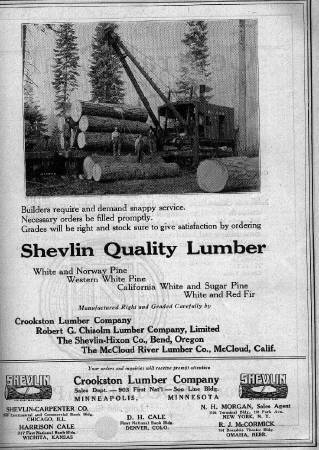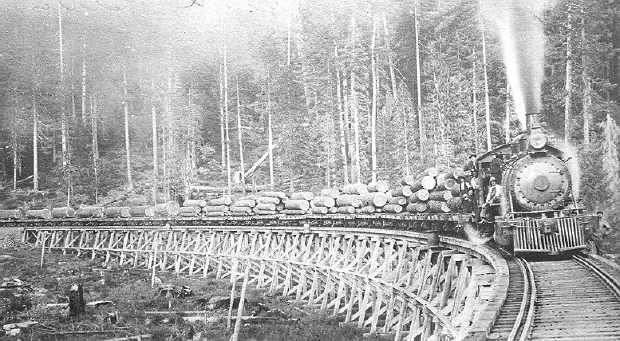|
McCloud River Railroad History: Part III
|
|||||||||||||||||||||||||||||
|
|
|||||||||||||||||||||||||||||
Two different classes of railroads were built in the McCloud operations, those lines built for the benefit and exclusive use of the lumber company, and those that became part of the common-carrier McCloud River Railroad. With a few exceptions, almost all of the common carrier tracks east of McCloud consisted of logging lines that became permanent.
Most of the trackage
used by the McCloud companies consisted of temporary log spurs laid down
by the lumber company to reach the area that was being logged at the moment,
and in most cases the trackage was removed as
soon as the trees were gone. In a few places
a long-lived trunk line that was fed by numerous spurs developed, and some
of these were made part of the common carrier operation if revenue (or potential
revenue) for something other than lumber company logs existed. In the early years the railroad owned and operated
the logging spurs on the behalf of the lumber company.
Many hundreds of miles of roadbed laid out by and for the lumber
company still exist winding through parts of Siskiyou, Shasta, and Modoc counties, but only a few dozen miles would be
operating at one time. The first of these
spurs were laid out directly from McCloud to tap stands of timber within
the first year of operations.
Traffic on the McCloud River Railroad
could be broken down into three basic categories. The
first was movement of raw logs from interchanges with the lumber company
railroads to the McCloud mill; the second was movement of commercial freight
between points on the railroad; and the third was passenger service. Commercial freight generally meant finished lumber
from the McCloud mill and other mills to connections with
the outside world as well as whatever other traffic that was offered to the
railroad by members of the general public. A
sidenote to the passenger traffic was the
less-than-carload freight and express business that was generally carried
in the same car as the passengers. Wells Fargo
and U.S. Mail contracts both made their way onto McCloud rails in the first
several years. A little over thirteen miles northeast
of McCloud lay a small mill known locally as the Holbrook Mill. The mill was built in 1891 and had operated sporadically
since, mostly due to the lack of decent and affordable transportation. The McCloud River Lumber Company purchased the sawmill
in late 1897/early 1898, and by late 1898 the first eastward extension of
the McCloud River Railroad was being constructed towards the mill. The McCloud River Lumber Company re-named the operation
as the Ash Creek Mill. Much money was poured
into the operation, and by the time that the McCloud River Railroad completed
construction to the mill in 1899 it was a first class sawmill. Combined daily output of the two McCloud sawmills
was 300,000 board feet. The McCloud River Railroad commenced
construction of a second line eastward out of McCloud in 1900. The new line was headed more or less for the small
settlement of Bartle, located about 18 miles
east of McCloud. Bartle
dated from 1887 when the Bartle brothers established
a cattle ranch in the area. The ranch was the
only real semblance of civilization on the rough stage roads that passed
through the area on their way from Sisson to the rich agricultural areas
of the Fall River and Big Valleys to the southeast, and before long a fine
hotel was built to house and feed travelers. A
post office known as Glazier was established in the late 1800s, and a newspaper,
the “McCloud River Pioneer” was published here between 1889 and 1893.
The McCloud River Railroad was having
trouble purchasing enough rail to keep up with the expanding system, and
a partial solution was found in the moribund Red Cross Lumber Company railroad
south of Sisson. Red Cross had operated a succession of two small
mills along the McCloud River near Bartle and had started construction of a railroad from
a point on the Central Pacific south of Dunsmuir towards the McCloud country. The company fell apart with two and a half miles
of rail down, and the McCloud River purchased the Red Cross railroad for
the rails involved. The company immediately moved
to salvage the railroad, and the rails were brought to McCloud for re-use.
The year 1902 saw an ownership change
in the company, as George Scott and William Van Arsdale
sold the company to a group of Minnesota capitalists.
A man named J. R. Wisdom soon arrived in McCloud to become general
manager of the two companies. The new owners
brought new capital to invest in the operations. One
of the first acts was to eliminate the switchback at Big Canyon through construction
of a large fill. The following year saw the Ash Creek
Mill destroyed by fire. The company decided after
some deliberation not to re-build the mill. Some
of the Ash Creek line was retained as log spurs for several years until the
forests in the area were cut out.
The McCloud River Railroad next concentrated
on reaching Bartle. The
railroad arrived there in 1905. Bartle became the transfer point for goods and people
heading to and from the Fall River and Big Valleys, and before long large
freight sheds were constructed to handle the interchange of traffic.
|
|||||||||||||||||||||||||||||

|
|||||||||||||||||||||||||||||
| Glen Comstock collection. |
|||||||||||||||||||||||||||||
|
Construction of the common carrier did not stop at Bartle. By the end of 1905 the railhead reached 3 miles beyond Bartle, heading in a northerly direction. The city of Klamath Falls was offering a substantial amount of money to the first railroad to be completed to the city, and several people saw the northward direction as a sign that the company was entering the race. Klamath Falls was a mere 75 miles from Bartle, 50 miles by land plus an additional 25 miles by steamship across Lower Klamath Lake. The year 1906 saw a few developments in the railroad. The railroad had leased space in the Southern Pacific headquarters building in San Francisco for its general headquarters for several years. The great earthquake on the morning of April 18th destroyed the SP building, along with all records of the McCloud River Railroad. Despite the loss, the re-building of San Francisco greatly increased the demand for McCloud forest products. Construction of the railroad beyond Bartle continued, with a new terminus at Milepost 58 (21 miles from Bartle) reached. Milepost 58 turned out to be as far north as the railroad would ever get. The lumber company did build several spurs north of Milepost 58 to reach harvest areas. The year 1907 saw a change in the western terminus of the railroad. Sisson donated some land to the company, and in return the railroad built a new line from a point above Sisson into the town, where a new interchange point was established with the Southern Pacific. The original line to Upton was immediately abandoned. The year 1914 saw another shift in ownership of the railroad. The railroad had been almost completely controlled by the lumber company for many years, with the lumber company holding 11,975 of the 12,000 authorized shares of McCloud River Railroad Company stock. The lumber company decided to divest itself of the railroad, in part to avoid any appearances that the lumber company might be in a position to exert undue influence in the affairs of the railroad. To accomplish the ownership shift the lumber company turned the railroad stock directly over to its own stockholders. The railroad thus became an independent property owner in McCloud, but its employees continued to live in lumber company housing and continued to enjoy all of the rights and privileges that the lumber company extended to its own employees. The railroad remained basically stable through the 1910s with the exception of the ever changing log spurs. Logging activity at the time was centered in the areas south of McCloud, between McCloud and Bartle, and north of Bartle. The area in the vicinity of Black Fox Mountain was the center of operations beginning about 1911. The McCloud River Railroad was (along with all of the nation’s other railroads) taken over by the United States Government during the first World War. The takeover had almost no impact on the road. The year 1919 saw a new agreement struck between the railroad and lumber companies over operation of the non-common carrier log lines. Since the inception of the company the railroad had built and operated all of the log lines on the behalf of the lumber company. The new agreement transferred all construction, operation, maintenance, and removal of the logging lines from the railroad to the lumber company. The actual rails used in the logging trackage were still owned by the railroad but leased to the lumber company. The lumber company acquired a fleet of small Plymouth gasoline-powered switchers that were used in construction and removal of log lines and movement of light log trains, with leased steam locomotives used to move heavy trains. The McCloud River Railroad did not operate beyond the limits of its common carrier tracks after 1919. |
|||||||||||||||||||||||||||||
| |||||||||||||||||||||||||||||
